Analyzing Lean Project Management for the FIFA World Cup 2018 Event
VerifiedAdded on 2023/06/07
|19
|3795
|442
Report
AI Summary
This report provides a comprehensive analysis of implementing lean project management principles for the FIFA World Cup 2018. It begins with an introduction highlighting the importance of effective project management for such a large-scale event, emphasizing the need to understand customer expectations and streamline processes. The report then delves into the voice of the customer (VOC), critical customer requirements (CCR), and critical to quality parameters (CTQ), explaining how these elements are crucial for project success. It outlines methodologies for capturing and analyzing customer needs, categorizing requirements, and establishing quality standards. The core of the report discusses the application of lean project management, including principles like reducing waste, enhancing customer voice, and managing value streams. It further elaborates on the use of PMBOK, PRINCE2, Agile practices, and Lean Six Sigma (DMAIC Methodology) to support lean project implementation, detailing best practices and processes. The report provides a clear structure of project management, including initiating, planning, executing, monitoring and controlling, and closing phases. It also explores the benefits of lean project management, such as reduced activity duration, efficient cost estimation, and increased profit. Finally, the report concludes with a detailed discussion of the project management lifecycle and the importance of adapting to changes, making it a valuable resource for students studying project management.

Project Management
Paraphrase This Document
Need a fresh take? Get an instant paraphrase of this document with our AI Paraphraser
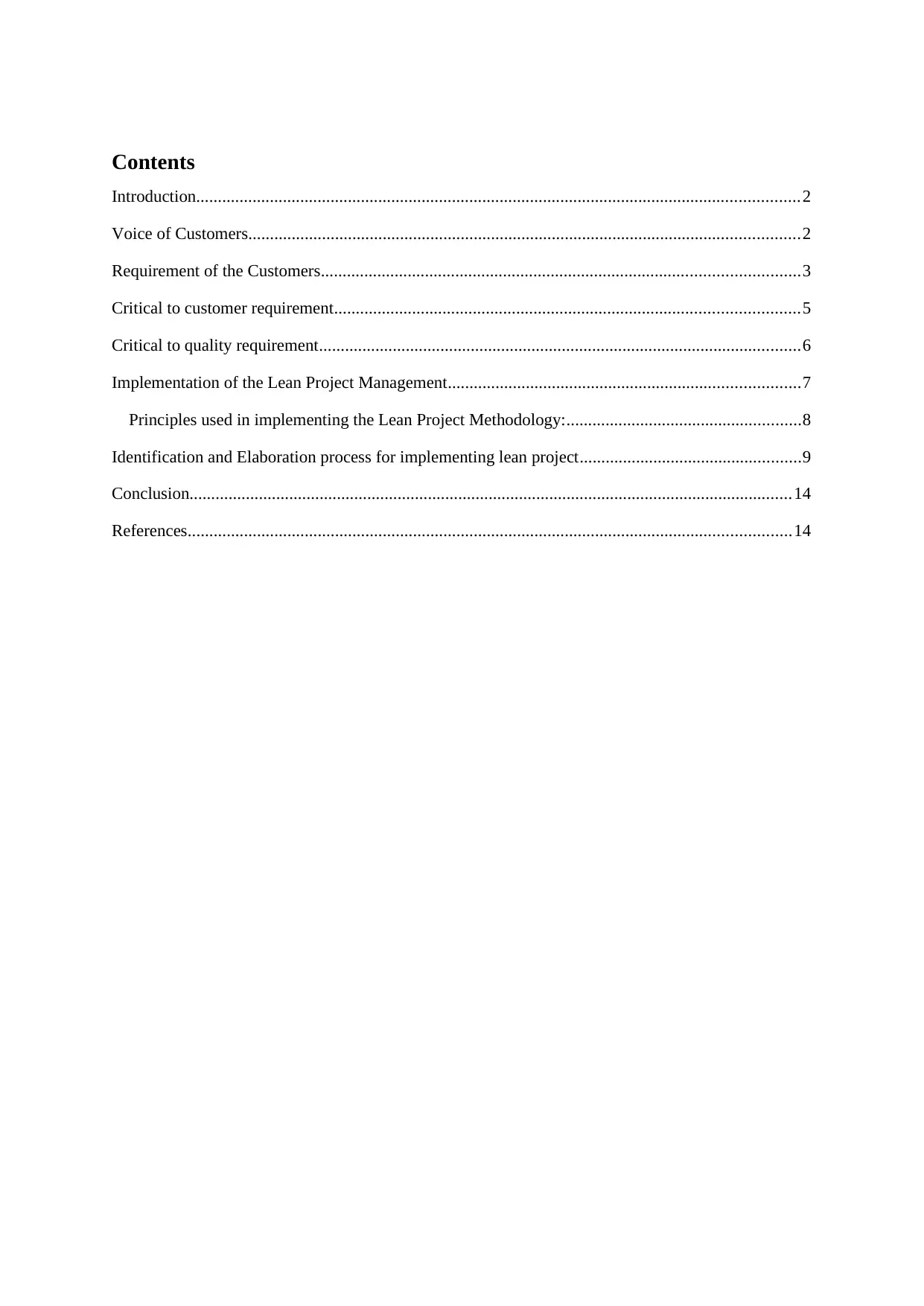
Contents
Introduction...........................................................................................................................................2
Voice of Customers...............................................................................................................................2
Requirement of the Customers..............................................................................................................3
Critical to customer requirement...........................................................................................................5
Critical to quality requirement...............................................................................................................6
Implementation of the Lean Project Management.................................................................................7
Principles used in implementing the Lean Project Methodology:......................................................8
Identification and Elaboration process for implementing lean project...................................................9
Conclusion...........................................................................................................................................14
References...........................................................................................................................................14
Introduction...........................................................................................................................................2
Voice of Customers...............................................................................................................................2
Requirement of the Customers..............................................................................................................3
Critical to customer requirement...........................................................................................................5
Critical to quality requirement...............................................................................................................6
Implementation of the Lean Project Management.................................................................................7
Principles used in implementing the Lean Project Methodology:......................................................8
Identification and Elaboration process for implementing lean project...................................................9
Conclusion...........................................................................................................................................14
References...........................................................................................................................................14
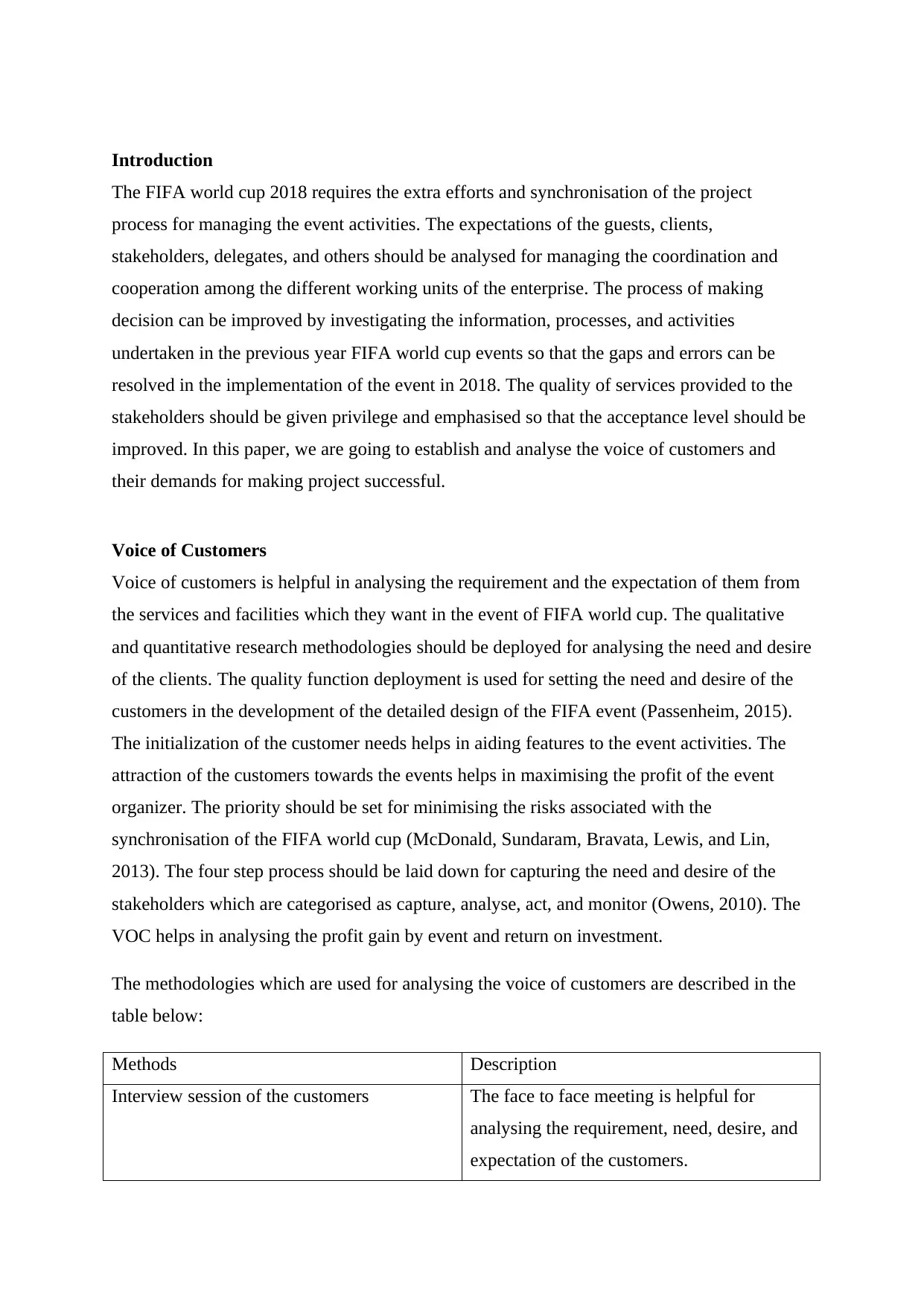
Introduction
The FIFA world cup 2018 requires the extra efforts and synchronisation of the project
process for managing the event activities. The expectations of the guests, clients,
stakeholders, delegates, and others should be analysed for managing the coordination and
cooperation among the different working units of the enterprise. The process of making
decision can be improved by investigating the information, processes, and activities
undertaken in the previous year FIFA world cup events so that the gaps and errors can be
resolved in the implementation of the event in 2018. The quality of services provided to the
stakeholders should be given privilege and emphasised so that the acceptance level should be
improved. In this paper, we are going to establish and analyse the voice of customers and
their demands for making project successful.
Voice of Customers
Voice of customers is helpful in analysing the requirement and the expectation of them from
the services and facilities which they want in the event of FIFA world cup. The qualitative
and quantitative research methodologies should be deployed for analysing the need and desire
of the clients. The quality function deployment is used for setting the need and desire of the
customers in the development of the detailed design of the FIFA event (Passenheim, 2015).
The initialization of the customer needs helps in aiding features to the event activities. The
attraction of the customers towards the events helps in maximising the profit of the event
organizer. The priority should be set for minimising the risks associated with the
synchronisation of the FIFA world cup (McDonald, Sundaram, Bravata, Lewis, and Lin,
2013). The four step process should be laid down for capturing the need and desire of the
stakeholders which are categorised as capture, analyse, act, and monitor (Owens, 2010). The
VOC helps in analysing the profit gain by event and return on investment.
The methodologies which are used for analysing the voice of customers are described in the
table below:
Methods Description
Interview session of the customers The face to face meeting is helpful for
analysing the requirement, need, desire, and
expectation of the customers.
The FIFA world cup 2018 requires the extra efforts and synchronisation of the project
process for managing the event activities. The expectations of the guests, clients,
stakeholders, delegates, and others should be analysed for managing the coordination and
cooperation among the different working units of the enterprise. The process of making
decision can be improved by investigating the information, processes, and activities
undertaken in the previous year FIFA world cup events so that the gaps and errors can be
resolved in the implementation of the event in 2018. The quality of services provided to the
stakeholders should be given privilege and emphasised so that the acceptance level should be
improved. In this paper, we are going to establish and analyse the voice of customers and
their demands for making project successful.
Voice of Customers
Voice of customers is helpful in analysing the requirement and the expectation of them from
the services and facilities which they want in the event of FIFA world cup. The qualitative
and quantitative research methodologies should be deployed for analysing the need and desire
of the clients. The quality function deployment is used for setting the need and desire of the
customers in the development of the detailed design of the FIFA event (Passenheim, 2015).
The initialization of the customer needs helps in aiding features to the event activities. The
attraction of the customers towards the events helps in maximising the profit of the event
organizer. The priority should be set for minimising the risks associated with the
synchronisation of the FIFA world cup (McDonald, Sundaram, Bravata, Lewis, and Lin,
2013). The four step process should be laid down for capturing the need and desire of the
stakeholders which are categorised as capture, analyse, act, and monitor (Owens, 2010). The
VOC helps in analysing the profit gain by event and return on investment.
The methodologies which are used for analysing the voice of customers are described in the
table below:
Methods Description
Interview session of the customers The face to face meeting is helpful for
analysing the requirement, need, desire, and
expectation of the customers.
⊘ This is a preview!⊘
Do you want full access?
Subscribe today to unlock all pages.

Trusted by 1+ million students worldwide
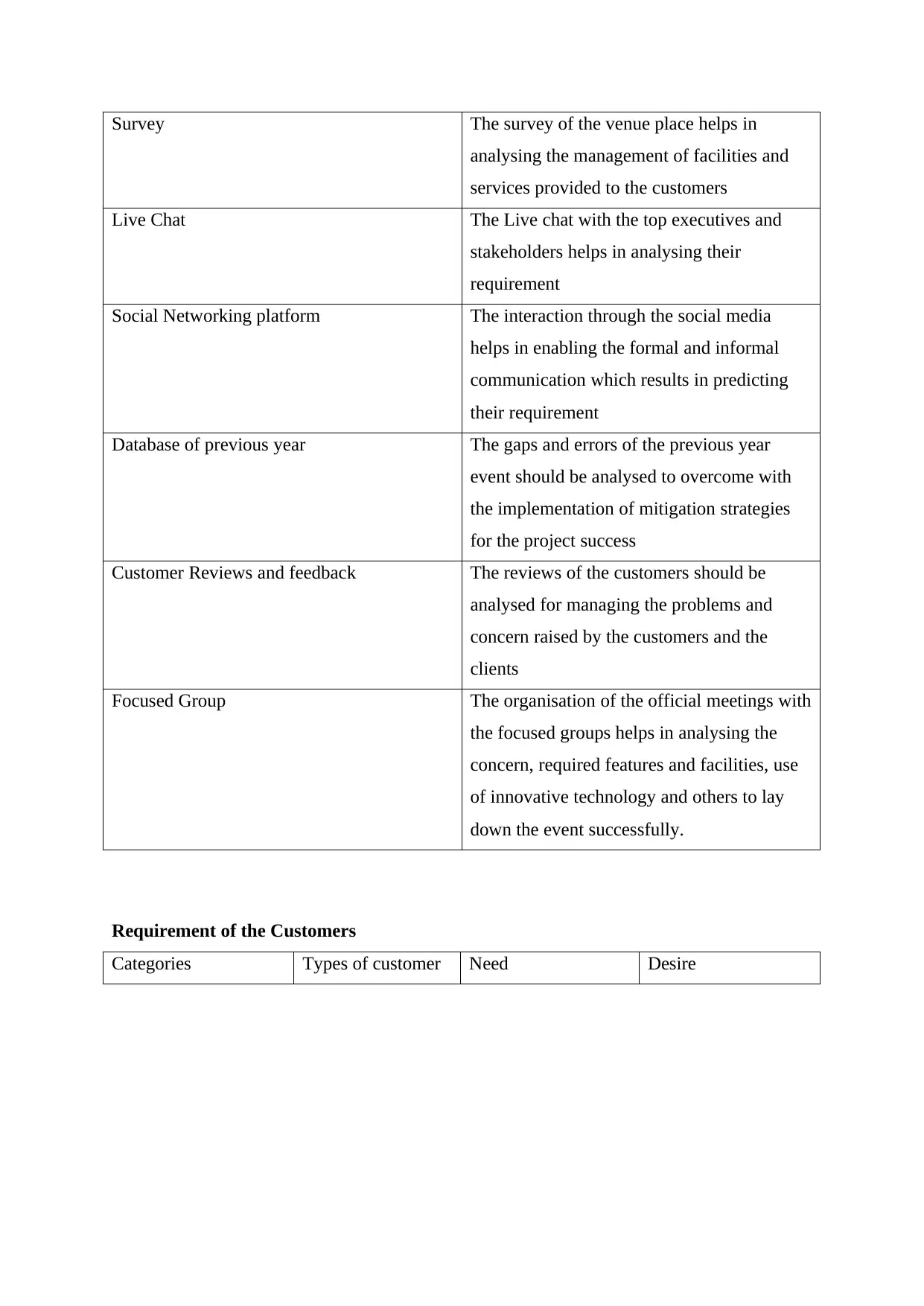
Survey The survey of the venue place helps in
analysing the management of facilities and
services provided to the customers
Live Chat The Live chat with the top executives and
stakeholders helps in analysing their
requirement
Social Networking platform The interaction through the social media
helps in enabling the formal and informal
communication which results in predicting
their requirement
Database of previous year The gaps and errors of the previous year
event should be analysed to overcome with
the implementation of mitigation strategies
for the project success
Customer Reviews and feedback The reviews of the customers should be
analysed for managing the problems and
concern raised by the customers and the
clients
Focused Group The organisation of the official meetings with
the focused groups helps in analysing the
concern, required features and facilities, use
of innovative technology and others to lay
down the event successfully.
Requirement of the Customers
Categories Types of customer Need Desire
analysing the management of facilities and
services provided to the customers
Live Chat The Live chat with the top executives and
stakeholders helps in analysing their
requirement
Social Networking platform The interaction through the social media
helps in enabling the formal and informal
communication which results in predicting
their requirement
Database of previous year The gaps and errors of the previous year
event should be analysed to overcome with
the implementation of mitigation strategies
for the project success
Customer Reviews and feedback The reviews of the customers should be
analysed for managing the problems and
concern raised by the customers and the
clients
Focused Group The organisation of the official meetings with
the focused groups helps in analysing the
concern, required features and facilities, use
of innovative technology and others to lay
down the event successfully.
Requirement of the Customers
Categories Types of customer Need Desire
Paraphrase This Document
Need a fresh take? Get an instant paraphrase of this document with our AI Paraphraser
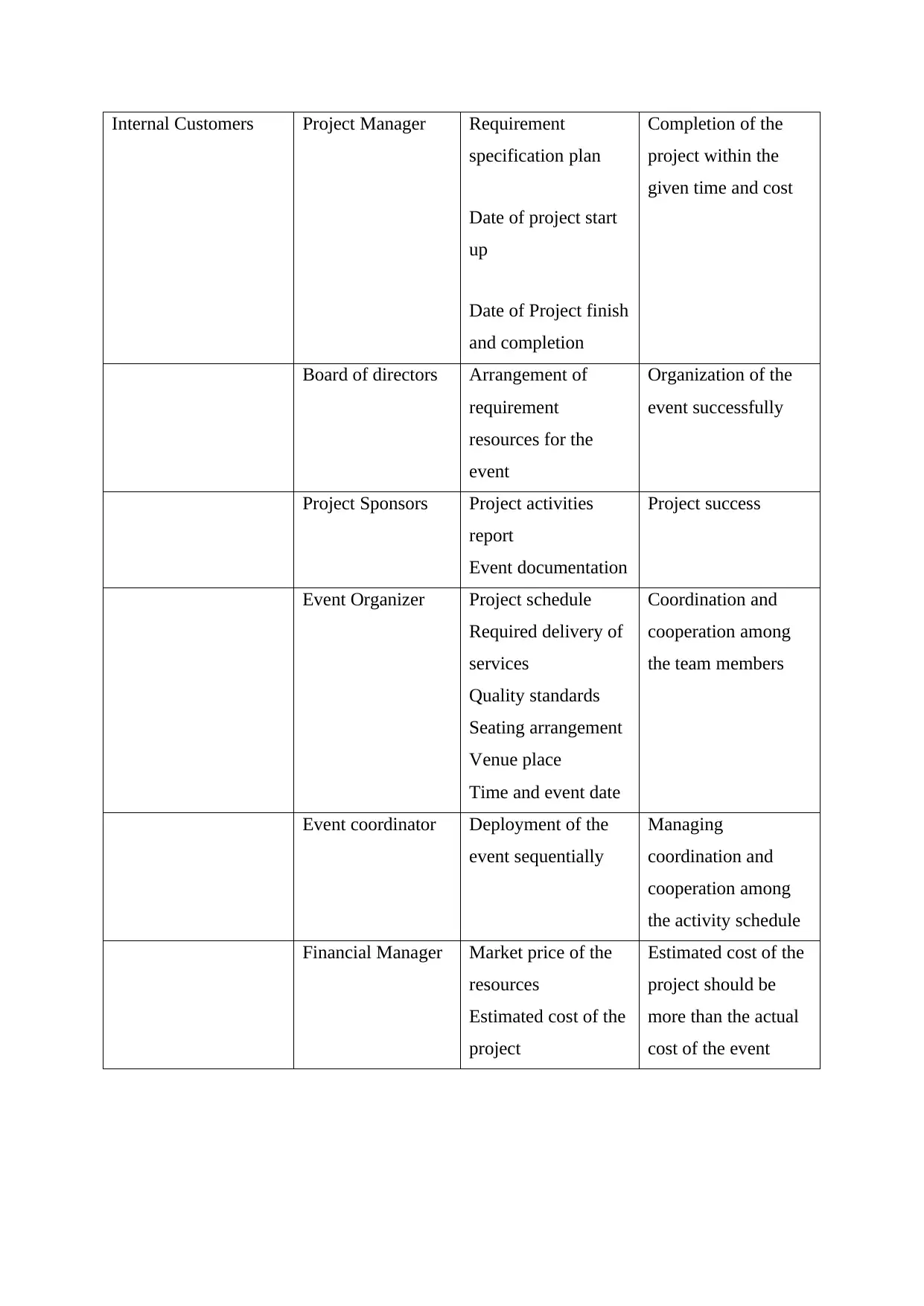
Internal Customers Project Manager Requirement
specification plan
Date of project start
up
Date of Project finish
and completion
Completion of the
project within the
given time and cost
Board of directors Arrangement of
requirement
resources for the
event
Organization of the
event successfully
Project Sponsors Project activities
report
Event documentation
Project success
Event Organizer Project schedule
Required delivery of
services
Quality standards
Seating arrangement
Venue place
Time and event date
Coordination and
cooperation among
the team members
Event coordinator Deployment of the
event sequentially
Managing
coordination and
cooperation among
the activity schedule
Financial Manager Market price of the
resources
Estimated cost of the
project
Estimated cost of the
project should be
more than the actual
cost of the event
specification plan
Date of project start
up
Date of Project finish
and completion
Completion of the
project within the
given time and cost
Board of directors Arrangement of
requirement
resources for the
event
Organization of the
event successfully
Project Sponsors Project activities
report
Event documentation
Project success
Event Organizer Project schedule
Required delivery of
services
Quality standards
Seating arrangement
Venue place
Time and event date
Coordination and
cooperation among
the team members
Event coordinator Deployment of the
event sequentially
Managing
coordination and
cooperation among
the activity schedule
Financial Manager Market price of the
resources
Estimated cost of the
project
Estimated cost of the
project should be
more than the actual
cost of the event
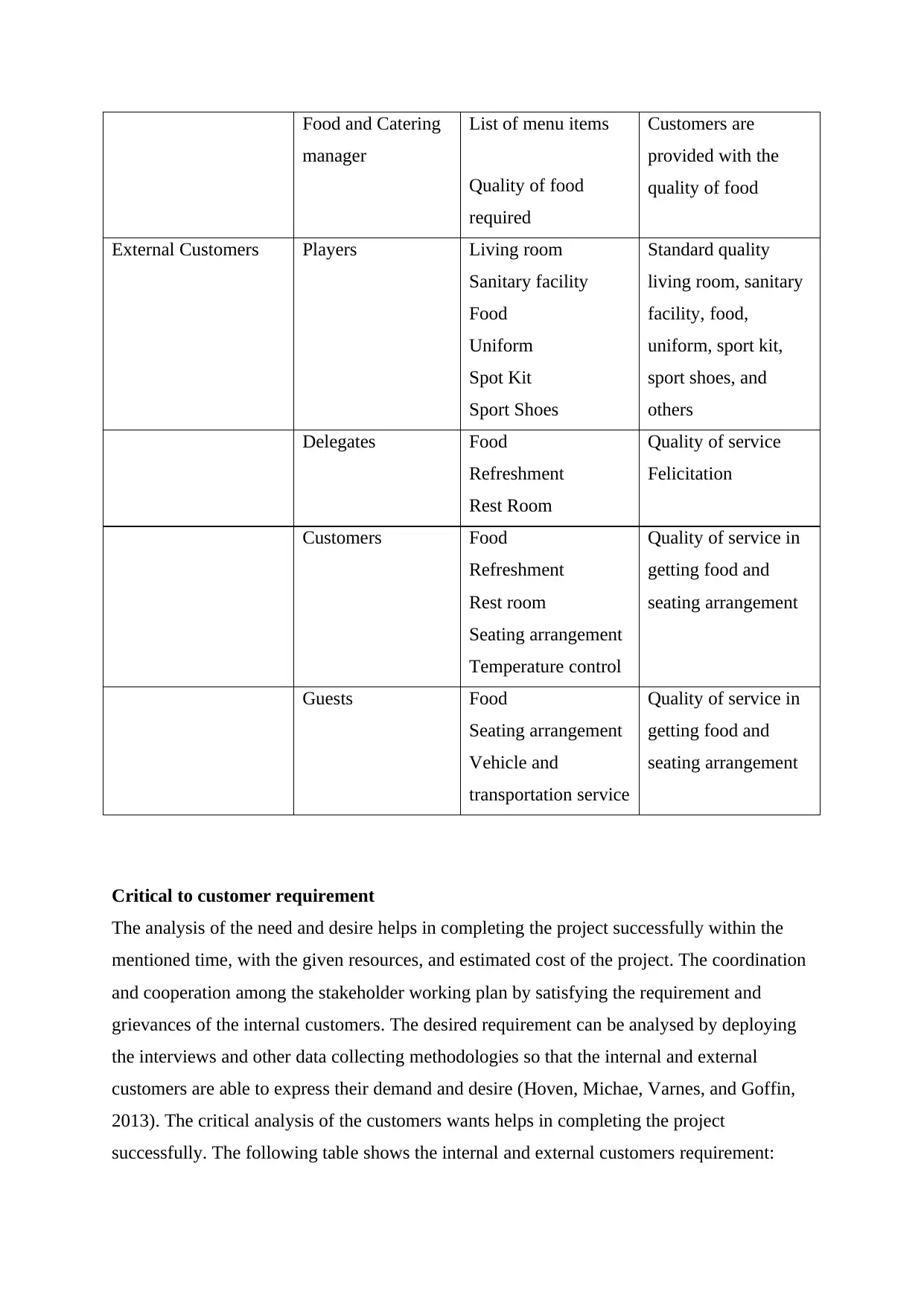
Food and Catering
manager
List of menu items
Quality of food
required
Customers are
provided with the
quality of food
External Customers Players Living room
Sanitary facility
Food
Uniform
Spot Kit
Sport Shoes
Standard quality
living room, sanitary
facility, food,
uniform, sport kit,
sport shoes, and
others
Delegates Food
Refreshment
Rest Room
Quality of service
Felicitation
Customers Food
Refreshment
Rest room
Seating arrangement
Temperature control
Quality of service in
getting food and
seating arrangement
Guests Food
Seating arrangement
Vehicle and
transportation service
Quality of service in
getting food and
seating arrangement
Critical to customer requirement
The analysis of the need and desire helps in completing the project successfully within the
mentioned time, with the given resources, and estimated cost of the project. The coordination
and cooperation among the stakeholder working plan by satisfying the requirement and
grievances of the internal customers. The desired requirement can be analysed by deploying
the interviews and other data collecting methodologies so that the internal and external
customers are able to express their demand and desire (Hoven, Michae, Varnes, and Goffin,
2013). The critical analysis of the customers wants helps in completing the project
successfully. The following table shows the internal and external customers requirement:
manager
List of menu items
Quality of food
required
Customers are
provided with the
quality of food
External Customers Players Living room
Sanitary facility
Food
Uniform
Spot Kit
Sport Shoes
Standard quality
living room, sanitary
facility, food,
uniform, sport kit,
sport shoes, and
others
Delegates Food
Refreshment
Rest Room
Quality of service
Felicitation
Customers Food
Refreshment
Rest room
Seating arrangement
Temperature control
Quality of service in
getting food and
seating arrangement
Guests Food
Seating arrangement
Vehicle and
transportation service
Quality of service in
getting food and
seating arrangement
Critical to customer requirement
The analysis of the need and desire helps in completing the project successfully within the
mentioned time, with the given resources, and estimated cost of the project. The coordination
and cooperation among the stakeholder working plan by satisfying the requirement and
grievances of the internal customers. The desired requirement can be analysed by deploying
the interviews and other data collecting methodologies so that the internal and external
customers are able to express their demand and desire (Hoven, Michae, Varnes, and Goffin,
2013). The critical analysis of the customers wants helps in completing the project
successfully. The following table shows the internal and external customers requirement:
⊘ This is a preview!⊘
Do you want full access?
Subscribe today to unlock all pages.

Trusted by 1+ million students worldwide
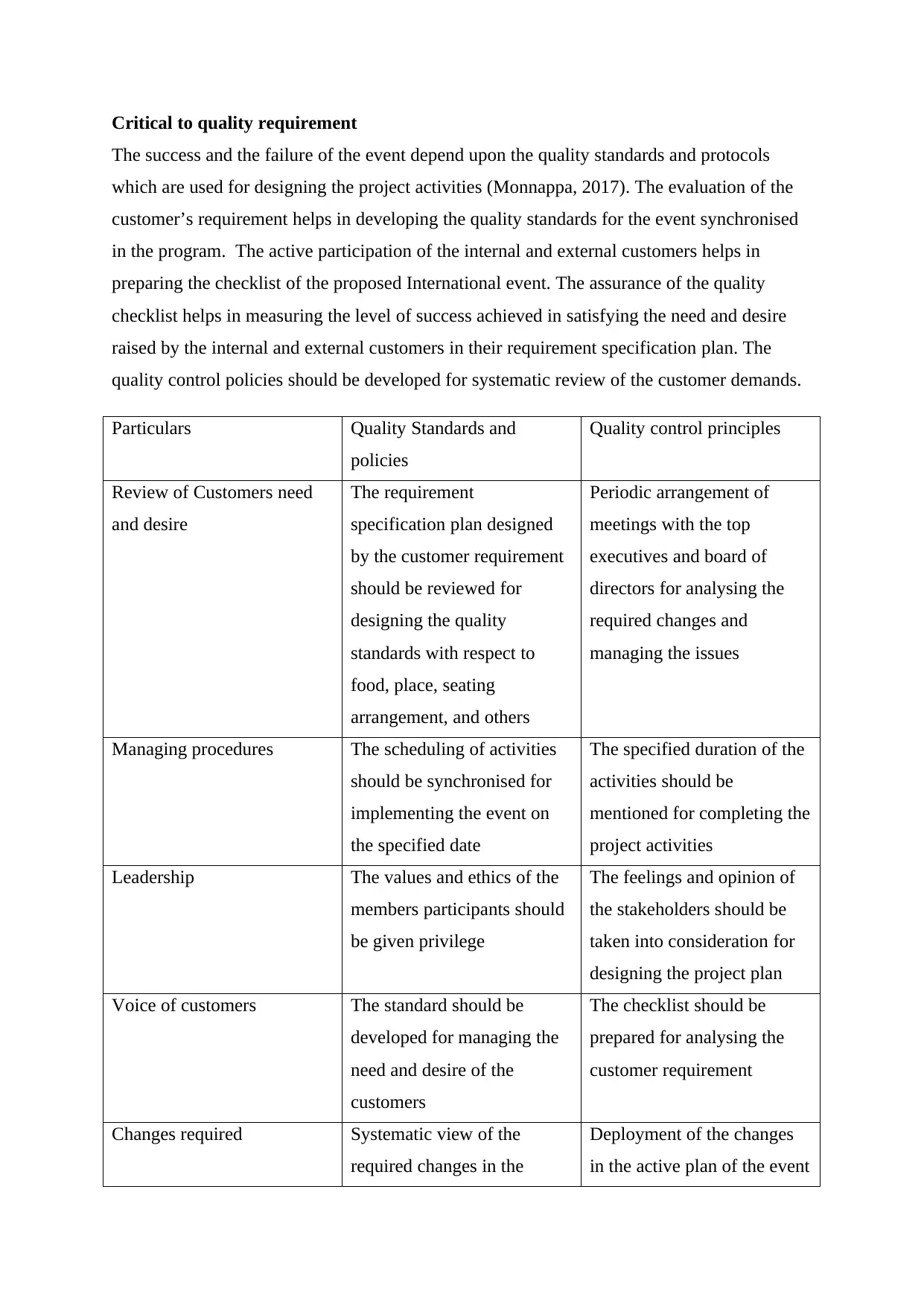
Critical to quality requirement
The success and the failure of the event depend upon the quality standards and protocols
which are used for designing the project activities (Monnappa, 2017). The evaluation of the
customer’s requirement helps in developing the quality standards for the event synchronised
in the program. The active participation of the internal and external customers helps in
preparing the checklist of the proposed International event. The assurance of the quality
checklist helps in measuring the level of success achieved in satisfying the need and desire
raised by the internal and external customers in their requirement specification plan. The
quality control policies should be developed for systematic review of the customer demands.
Particulars Quality Standards and
policies
Quality control principles
Review of Customers need
and desire
The requirement
specification plan designed
by the customer requirement
should be reviewed for
designing the quality
standards with respect to
food, place, seating
arrangement, and others
Periodic arrangement of
meetings with the top
executives and board of
directors for analysing the
required changes and
managing the issues
Managing procedures The scheduling of activities
should be synchronised for
implementing the event on
the specified date
The specified duration of the
activities should be
mentioned for completing the
project activities
Leadership The values and ethics of the
members participants should
be given privilege
The feelings and opinion of
the stakeholders should be
taken into consideration for
designing the project plan
Voice of customers The standard should be
developed for managing the
need and desire of the
customers
The checklist should be
prepared for analysing the
customer requirement
Changes required Systematic view of the
required changes in the
Deployment of the changes
in the active plan of the event
The success and the failure of the event depend upon the quality standards and protocols
which are used for designing the project activities (Monnappa, 2017). The evaluation of the
customer’s requirement helps in developing the quality standards for the event synchronised
in the program. The active participation of the internal and external customers helps in
preparing the checklist of the proposed International event. The assurance of the quality
checklist helps in measuring the level of success achieved in satisfying the need and desire
raised by the internal and external customers in their requirement specification plan. The
quality control policies should be developed for systematic review of the customer demands.
Particulars Quality Standards and
policies
Quality control principles
Review of Customers need
and desire
The requirement
specification plan designed
by the customer requirement
should be reviewed for
designing the quality
standards with respect to
food, place, seating
arrangement, and others
Periodic arrangement of
meetings with the top
executives and board of
directors for analysing the
required changes and
managing the issues
Managing procedures The scheduling of activities
should be synchronised for
implementing the event on
the specified date
The specified duration of the
activities should be
mentioned for completing the
project activities
Leadership The values and ethics of the
members participants should
be given privilege
The feelings and opinion of
the stakeholders should be
taken into consideration for
designing the project plan
Voice of customers The standard should be
developed for managing the
need and desire of the
customers
The checklist should be
prepared for analysing the
customer requirement
Changes required Systematic view of the
required changes in the
Deployment of the changes
in the active plan of the event
Paraphrase This Document
Need a fresh take? Get an instant paraphrase of this document with our AI Paraphraser
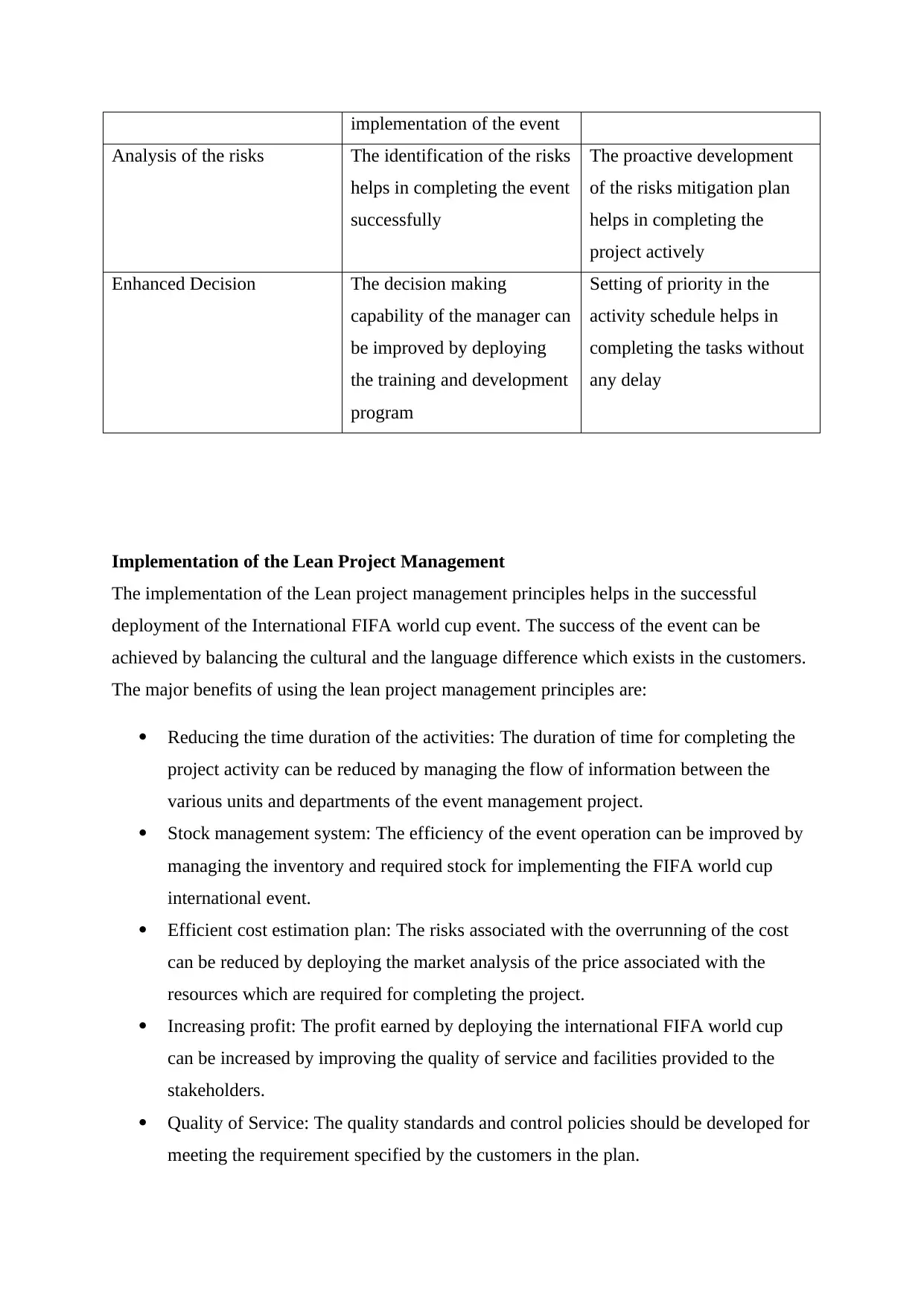
implementation of the event
Analysis of the risks The identification of the risks
helps in completing the event
successfully
The proactive development
of the risks mitigation plan
helps in completing the
project actively
Enhanced Decision The decision making
capability of the manager can
be improved by deploying
the training and development
program
Setting of priority in the
activity schedule helps in
completing the tasks without
any delay
Implementation of the Lean Project Management
The implementation of the Lean project management principles helps in the successful
deployment of the International FIFA world cup event. The success of the event can be
achieved by balancing the cultural and the language difference which exists in the customers.
The major benefits of using the lean project management principles are:
Reducing the time duration of the activities: The duration of time for completing the
project activity can be reduced by managing the flow of information between the
various units and departments of the event management project.
Stock management system: The efficiency of the event operation can be improved by
managing the inventory and required stock for implementing the FIFA world cup
international event.
Efficient cost estimation plan: The risks associated with the overrunning of the cost
can be reduced by deploying the market analysis of the price associated with the
resources which are required for completing the project.
Increasing profit: The profit earned by deploying the international FIFA world cup
can be increased by improving the quality of service and facilities provided to the
stakeholders.
Quality of Service: The quality standards and control policies should be developed for
meeting the requirement specified by the customers in the plan.
Analysis of the risks The identification of the risks
helps in completing the event
successfully
The proactive development
of the risks mitigation plan
helps in completing the
project actively
Enhanced Decision The decision making
capability of the manager can
be improved by deploying
the training and development
program
Setting of priority in the
activity schedule helps in
completing the tasks without
any delay
Implementation of the Lean Project Management
The implementation of the Lean project management principles helps in the successful
deployment of the International FIFA world cup event. The success of the event can be
achieved by balancing the cultural and the language difference which exists in the customers.
The major benefits of using the lean project management principles are:
Reducing the time duration of the activities: The duration of time for completing the
project activity can be reduced by managing the flow of information between the
various units and departments of the event management project.
Stock management system: The efficiency of the event operation can be improved by
managing the inventory and required stock for implementing the FIFA world cup
international event.
Efficient cost estimation plan: The risks associated with the overrunning of the cost
can be reduced by deploying the market analysis of the price associated with the
resources which are required for completing the project.
Increasing profit: The profit earned by deploying the international FIFA world cup
can be increased by improving the quality of service and facilities provided to the
stakeholders.
Quality of Service: The quality standards and control policies should be developed for
meeting the requirement specified by the customers in the plan.
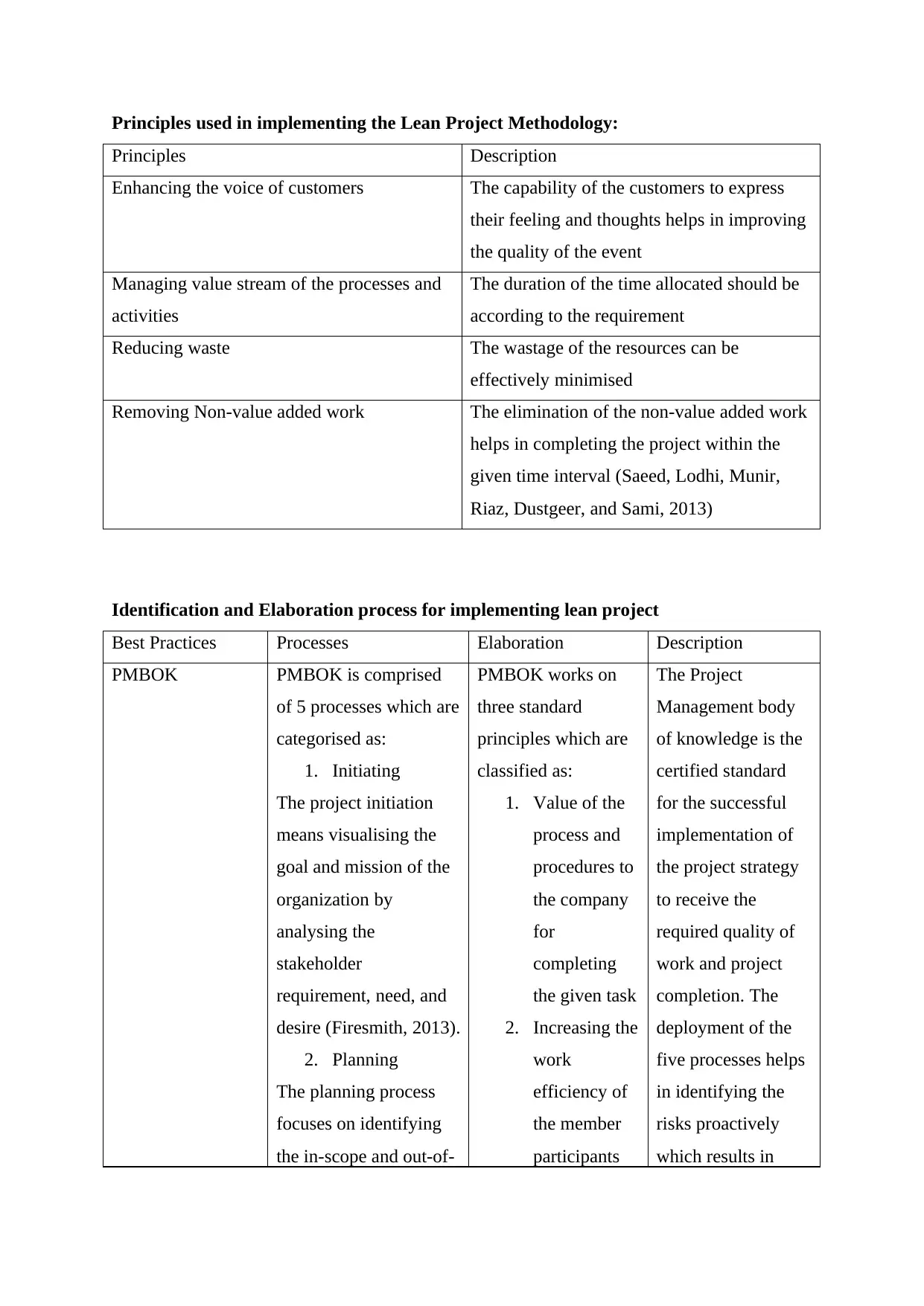
Principles used in implementing the Lean Project Methodology:
Principles Description
Enhancing the voice of customers The capability of the customers to express
their feeling and thoughts helps in improving
the quality of the event
Managing value stream of the processes and
activities
The duration of the time allocated should be
according to the requirement
Reducing waste The wastage of the resources can be
effectively minimised
Removing Non-value added work The elimination of the non-value added work
helps in completing the project within the
given time interval (Saeed, Lodhi, Munir,
Riaz, Dustgeer, and Sami, 2013)
Identification and Elaboration process for implementing lean project
Best Practices Processes Elaboration Description
PMBOK PMBOK is comprised
of 5 processes which are
categorised as:
1. Initiating
The project initiation
means visualising the
goal and mission of the
organization by
analysing the
stakeholder
requirement, need, and
desire (Firesmith, 2013).
2. Planning
The planning process
focuses on identifying
the in-scope and out-of-
PMBOK works on
three standard
principles which are
classified as:
1. Value of the
process and
procedures to
the company
for
completing
the given task
2. Increasing the
work
efficiency of
the member
participants
The Project
Management body
of knowledge is the
certified standard
for the successful
implementation of
the project strategy
to receive the
required quality of
work and project
completion. The
deployment of the
five processes helps
in identifying the
risks proactively
which results in
Principles Description
Enhancing the voice of customers The capability of the customers to express
their feeling and thoughts helps in improving
the quality of the event
Managing value stream of the processes and
activities
The duration of the time allocated should be
according to the requirement
Reducing waste The wastage of the resources can be
effectively minimised
Removing Non-value added work The elimination of the non-value added work
helps in completing the project within the
given time interval (Saeed, Lodhi, Munir,
Riaz, Dustgeer, and Sami, 2013)
Identification and Elaboration process for implementing lean project
Best Practices Processes Elaboration Description
PMBOK PMBOK is comprised
of 5 processes which are
categorised as:
1. Initiating
The project initiation
means visualising the
goal and mission of the
organization by
analysing the
stakeholder
requirement, need, and
desire (Firesmith, 2013).
2. Planning
The planning process
focuses on identifying
the in-scope and out-of-
PMBOK works on
three standard
principles which are
classified as:
1. Value of the
process and
procedures to
the company
for
completing
the given task
2. Increasing the
work
efficiency of
the member
participants
The Project
Management body
of knowledge is the
certified standard
for the successful
implementation of
the project strategy
to receive the
required quality of
work and project
completion. The
deployment of the
five processes helps
in identifying the
risks proactively
which results in
⊘ This is a preview!⊘
Do you want full access?
Subscribe today to unlock all pages.

Trusted by 1+ million students worldwide
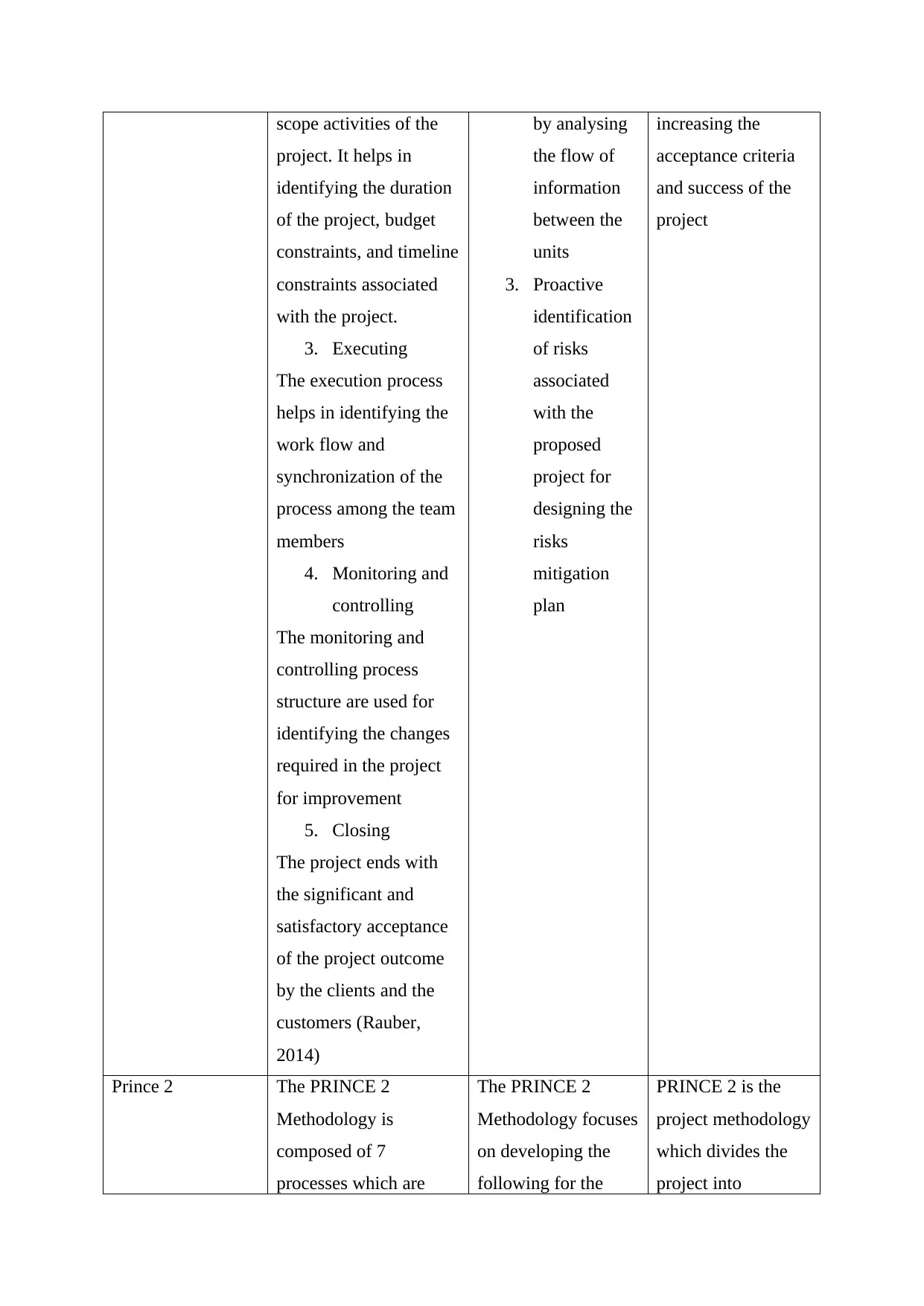
scope activities of the
project. It helps in
identifying the duration
of the project, budget
constraints, and timeline
constraints associated
with the project.
3. Executing
The execution process
helps in identifying the
work flow and
synchronization of the
process among the team
members
4. Monitoring and
controlling
The monitoring and
controlling process
structure are used for
identifying the changes
required in the project
for improvement
5. Closing
The project ends with
the significant and
satisfactory acceptance
of the project outcome
by the clients and the
customers (Rauber,
2014)
by analysing
the flow of
information
between the
units
3. Proactive
identification
of risks
associated
with the
proposed
project for
designing the
risks
mitigation
plan
increasing the
acceptance criteria
and success of the
project
Prince 2 The PRINCE 2
Methodology is
composed of 7
processes which are
The PRINCE 2
Methodology focuses
on developing the
following for the
PRINCE 2 is the
project methodology
which divides the
project into
project. It helps in
identifying the duration
of the project, budget
constraints, and timeline
constraints associated
with the project.
3. Executing
The execution process
helps in identifying the
work flow and
synchronization of the
process among the team
members
4. Monitoring and
controlling
The monitoring and
controlling process
structure are used for
identifying the changes
required in the project
for improvement
5. Closing
The project ends with
the significant and
satisfactory acceptance
of the project outcome
by the clients and the
customers (Rauber,
2014)
by analysing
the flow of
information
between the
units
3. Proactive
identification
of risks
associated
with the
proposed
project for
designing the
risks
mitigation
plan
increasing the
acceptance criteria
and success of the
project
Prince 2 The PRINCE 2
Methodology is
composed of 7
processes which are
The PRINCE 2
Methodology focuses
on developing the
following for the
PRINCE 2 is the
project methodology
which divides the
project into
Paraphrase This Document
Need a fresh take? Get an instant paraphrase of this document with our AI Paraphraser
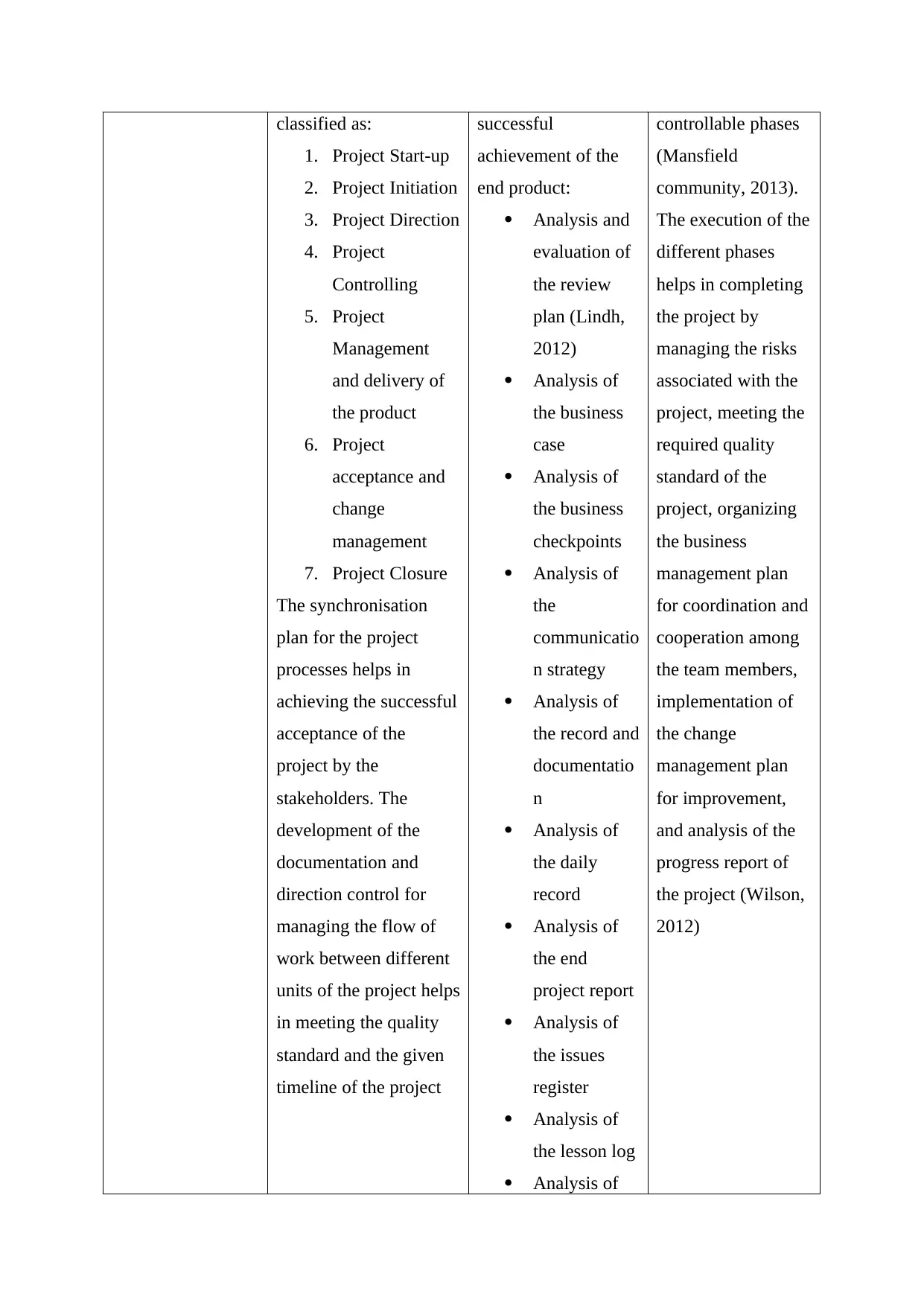
classified as:
1. Project Start-up
2. Project Initiation
3. Project Direction
4. Project
Controlling
5. Project
Management
and delivery of
the product
6. Project
acceptance and
change
management
7. Project Closure
The synchronisation
plan for the project
processes helps in
achieving the successful
acceptance of the
project by the
stakeholders. The
development of the
documentation and
direction control for
managing the flow of
work between different
units of the project helps
in meeting the quality
standard and the given
timeline of the project
successful
achievement of the
end product:
Analysis and
evaluation of
the review
plan (Lindh,
2012)
Analysis of
the business
case
Analysis of
the business
checkpoints
Analysis of
the
communicatio
n strategy
Analysis of
the record and
documentatio
n
Analysis of
the daily
record
Analysis of
the end
project report
Analysis of
the issues
register
Analysis of
the lesson log
Analysis of
controllable phases
(Mansfield
community, 2013).
The execution of the
different phases
helps in completing
the project by
managing the risks
associated with the
project, meeting the
required quality
standard of the
project, organizing
the business
management plan
for coordination and
cooperation among
the team members,
implementation of
the change
management plan
for improvement,
and analysis of the
progress report of
the project (Wilson,
2012)
1. Project Start-up
2. Project Initiation
3. Project Direction
4. Project
Controlling
5. Project
Management
and delivery of
the product
6. Project
acceptance and
change
management
7. Project Closure
The synchronisation
plan for the project
processes helps in
achieving the successful
acceptance of the
project by the
stakeholders. The
development of the
documentation and
direction control for
managing the flow of
work between different
units of the project helps
in meeting the quality
standard and the given
timeline of the project
successful
achievement of the
end product:
Analysis and
evaluation of
the review
plan (Lindh,
2012)
Analysis of
the business
case
Analysis of
the business
checkpoints
Analysis of
the
communicatio
n strategy
Analysis of
the record and
documentatio
n
Analysis of
the daily
record
Analysis of
the end
project report
Analysis of
the issues
register
Analysis of
the lesson log
Analysis of
controllable phases
(Mansfield
community, 2013).
The execution of the
different phases
helps in completing
the project by
managing the risks
associated with the
project, meeting the
required quality
standard of the
project, organizing
the business
management plan
for coordination and
cooperation among
the team members,
implementation of
the change
management plan
for improvement,
and analysis of the
progress report of
the project (Wilson,
2012)
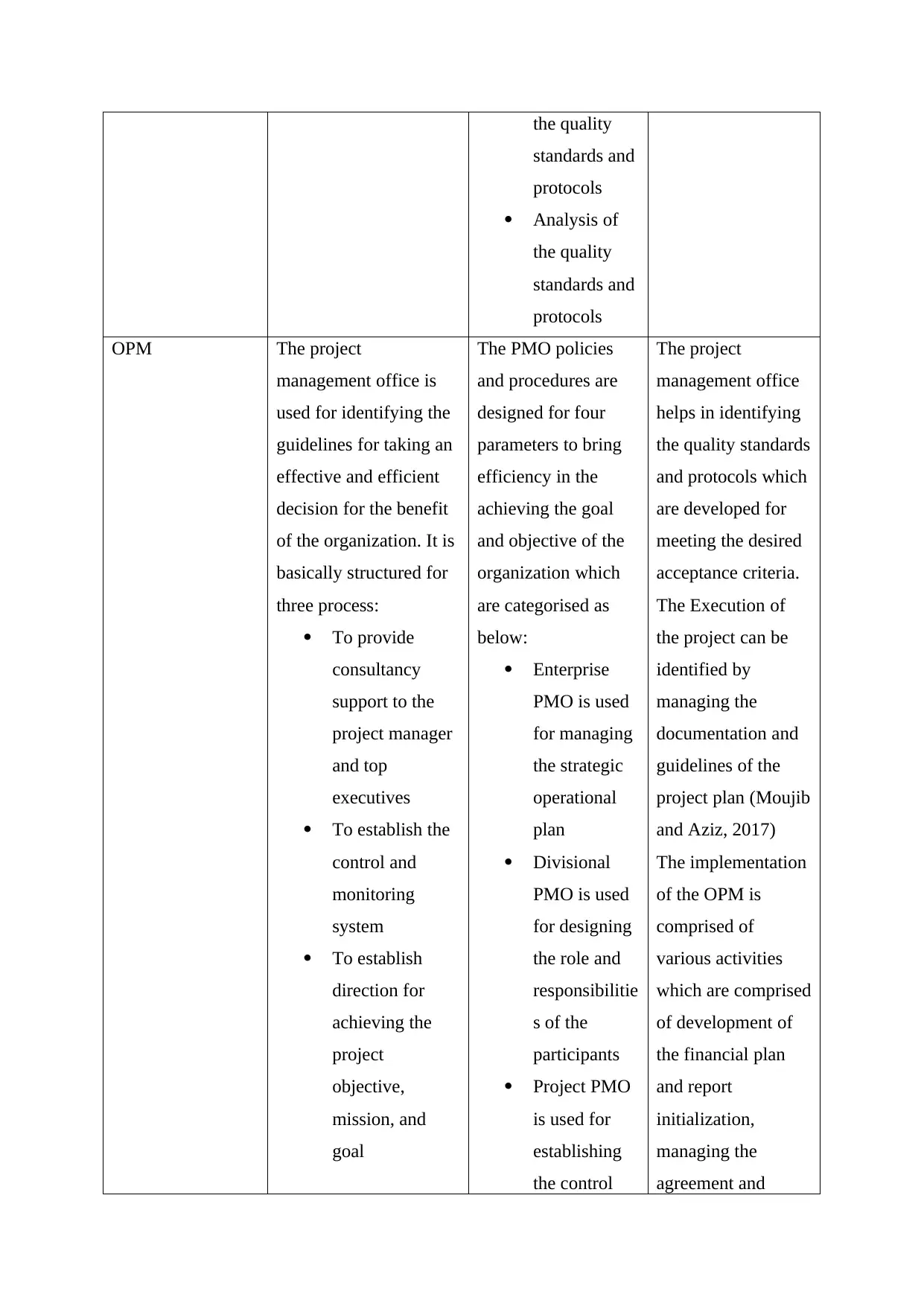
the quality
standards and
protocols
Analysis of
the quality
standards and
protocols
OPM The project
management office is
used for identifying the
guidelines for taking an
effective and efficient
decision for the benefit
of the organization. It is
basically structured for
three process:
To provide
consultancy
support to the
project manager
and top
executives
To establish the
control and
monitoring
system
To establish
direction for
achieving the
project
objective,
mission, and
goal
The PMO policies
and procedures are
designed for four
parameters to bring
efficiency in the
achieving the goal
and objective of the
organization which
are categorised as
below:
Enterprise
PMO is used
for managing
the strategic
operational
plan
Divisional
PMO is used
for designing
the role and
responsibilitie
s of the
participants
Project PMO
is used for
establishing
the control
The project
management office
helps in identifying
the quality standards
and protocols which
are developed for
meeting the desired
acceptance criteria.
The Execution of
the project can be
identified by
managing the
documentation and
guidelines of the
project plan (Moujib
and Aziz, 2017)
The implementation
of the OPM is
comprised of
various activities
which are comprised
of development of
the financial plan
and report
initialization,
managing the
agreement and
standards and
protocols
Analysis of
the quality
standards and
protocols
OPM The project
management office is
used for identifying the
guidelines for taking an
effective and efficient
decision for the benefit
of the organization. It is
basically structured for
three process:
To provide
consultancy
support to the
project manager
and top
executives
To establish the
control and
monitoring
system
To establish
direction for
achieving the
project
objective,
mission, and
goal
The PMO policies
and procedures are
designed for four
parameters to bring
efficiency in the
achieving the goal
and objective of the
organization which
are categorised as
below:
Enterprise
PMO is used
for managing
the strategic
operational
plan
Divisional
PMO is used
for designing
the role and
responsibilitie
s of the
participants
Project PMO
is used for
establishing
the control
The project
management office
helps in identifying
the quality standards
and protocols which
are developed for
meeting the desired
acceptance criteria.
The Execution of
the project can be
identified by
managing the
documentation and
guidelines of the
project plan (Moujib
and Aziz, 2017)
The implementation
of the OPM is
comprised of
various activities
which are comprised
of development of
the financial plan
and report
initialization,
managing the
agreement and
⊘ This is a preview!⊘
Do you want full access?
Subscribe today to unlock all pages.

Trusted by 1+ million students worldwide
1 out of 19
Related Documents
Your All-in-One AI-Powered Toolkit for Academic Success.
+13062052269
info@desklib.com
Available 24*7 on WhatsApp / Email
![[object Object]](/_next/static/media/star-bottom.7253800d.svg)
Unlock your academic potential
Copyright © 2020–2025 A2Z Services. All Rights Reserved. Developed and managed by ZUCOL.


